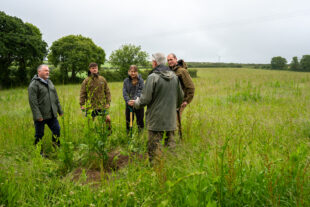https://defrafarming.blog.gov.uk/create-ponds-and-lakes/
Create ponds and lakes
The guidance on this page is for SFI pilot participants only. Please visit GOV.UK for the official Sustainable Farming Incentive scheme guidance.
Find out how land managers can create new clean freshwater ponds and lakes to benefit wildlife and improve the landscape.
If you’re completing this action as part of the Sustainable Farming Incentive pilot, how you do it is up to you.
The advice on this page can help you get better environmental and business benefits, but you do not have to follow it to get paid.
About ponds and lakes
Ponds are usually smaller than 2 hectares (ha) in area. They can hold water all year or dry out for a period in the summer.
Lakes are larger than 2ha and are deep enough to have areas where sunlight cannot reach the bottom.
Clean freshwater ponds and lakes are priority wildlife habitats. When creating ponds and lakes on your land it’s important that they’re suitable for wildlife.
Where to create ponds and lakes
Create a pond where it will be fed by clean water. You’ll be more likely to have clean water if you create ponds on land where you do not add nutrients, like no-input grassland.
On other land you may need to create and maintain riparian buffer strips to trap sediment and runoff.
Wildlife ponds can provide benefits in all types of farmland and urban areas. If possible, dig your pond or lake close to others in the area and connect them with grass strips, scrub or hedges. This provides ‘stepping stones’ for wildlife to move across the landscape.
Ponds surrounded by habitats like species-rich grassland, woodland, heathland or wetlands are likely to be best for wildlife. Make sure that you do not destroy existing wildlife if you create ponds in these areas. If you’re not sure, get advice from a pond specialist.
Do not create a wildlife pond or lake for:
- irrigation
- retaining flood water
- intercepting drainage water or pollution
- stocking fish
- rearing or feeding game birds or wildfowl
- boating or other water sports
Avoid digging ponds or lakes where they’ll be:
- contaminated by runoff from roads, yards, tracks, arable fields or manure heaps
- connected to drainage ditches or watercourses that could bring in polluted water or silt
- regularly disturbed by people walking dogs or feeding ducks
Do not dig ponds or lakes in:
- areas with historic or geodiversity features
- existing important habitats, like natural springs or damp, wet depressions
- historic, designed landscapes, such as parkland
- riverbanks or flood defences
Avoid digging ponds in peat soils, unless they’re part of a rare species recovery project in habitats like fens or bogs.
Check that excavation will not damage below-ground services like sewer pipes or buried electric cables.
Find out more about the best places to create ponds and lakes.
Benefits of creating ponds and lakes
Almost 70% of ponds have been lost since the 19th century, largely due to drainage and infilling. More lakes have survived but they support less biodiversity than they did.
New ponds can help to replace lost ponds and lakes. You can also make sure that the water is clean, as poor water quality is a threat to wildlife in many existing ponds.
Creating new ponds and lakes with clean water will provide a vital refuge for many freshwater plants and animals that are now rare or threatened. They can also provide resources for amphibians and land-based species which need fresh water.
Other benefits include:
- food for a wide range of species
- nest sites for birds
- flowering plants for pollinators
- drinking water for wildlife and livestock
- recreation and educational opportunities
- improvements to the visual aspect of the landscape
Permission and legal requirements
You may need planning permission to create a pond or lake. Contact your local planning authority with details of where you plan to do the work to find out if you need permission.
You can create ponds and lakes at any time of the year but do not disturb protected species, like nesting birds. Birds, nests and eggs are protected by law. You must check the area for birds before you start digging. If you see signs of nesting birds, delay digging until birds fledge.
Excavations in some areas could cause flooding. You should find out if you need an environmental permit if the pond or lake will be:
- near a main river
- near a flood or sea defence structure
- in the floodplain
You may also need to apply for a waste transfer note if you’re removing spoil.
If your land is part of a site of special scientific interest (SSSI), you must find out whether you need consent to dig a pond or lake before you start.
How to create ponds and lakes
Plan new ponds and lakes
It’s a good idea to design your pond or lake on paper or on a computer before you start.
You can create ponds and lakes in all soil types but in sand, gravel or peat, they may not retain water unless groundwater levels are close to the surface.
You may benefit from digging trial pits in the area so you can watch how they fill up and whether they hold water. These do not need to be wider than a single scoop from an excavator bucket, down to the maximum depth you plan for the pond.
Water levels should fluctuate naturally throughout the year. These changes create important areas of marginal habitat, which are usually underwater in winter but exposed in summer.
Seasonal ponds provide additional wildlife benefits than ponds that stay full all year round. For example, this reduces fish populations which is good for amphibians and invertebrates.
The cleanest water is from groundwater, or surface water that drains from unpolluted land. Check the catchment area if using surface water, because pollution is the most common cause of problems in ponds and lakes. Do not use streams, ditches and drains as a water source because they can carry polluted water and silt, which significantly reduce the quality and lifespan of ponds and lakes.
If possible, create several small ponds of different shapes, sizes and depths rather than a single large pond. This increases the variety of habitats, which in turn supports more wildlife.
The edges of ponds and lakes are usually the richest areas for wildlife. To increase this habitat, create long, irregular shaped edges and shallow, undulating banks. Some species prefer cold, deep water, while others need warmer, shallower water. Aim to vary the depth of the pond or lakebed.
Plan how you’ll manage the pond and the surrounding vegetation once it becomes established.
You may be able to create ponds without digging. You can:
- allow existing depressions to fill with water when you block field drains
- raise water levels when you restore wetland habitats like bogs and fens
- restore natural river systems and allow floodplain channels to become cut off to form ponds
Find out more about pond design.
Dig ponds and lakes
You should be able to dig 2 ponds (of between 200 square metres and 500 square metres) in one day with a 15 tonne machine. Allow extra time for fine tuning and tidying up. You’ll probably need a heavier machine, and certainly more time, to create larger ponds and lakes.
Ideally, strip the topsoil from the site and remove it before you start digging. This will reduce the amount of nutrients entering the water. Excess nutrients can pollute the water and encourage the growth of algae.
With the topsoil removed, you could use some subsoil to create different depths to the pond or lakebed. You could also use the subsoil to sculpt a varied shoreline.
Create plenty of shallow areas (less than 10cm deep) around the edges. Slopes should be no more than 1:5 (12 degrees) and preferably less than 1:20 (3 degrees).
Use the teeth of the excavator bucket to create mounds and hollows around the pond or lake edge. This will create niches for different species to colonise.
Spread any remaining subsoil away from the site if possible. Do not spread any material, especially topsoil, uphill of the pond or lake because soil and nutrients will wash into the water. Spreading uphill will also block surface runoff and restrict the water supply.
You can use some of the spoil to create south-facing banks as basking sites for reptiles or as beetle banks.
Allow the pond or lake to fill naturally. Where you have a porous, gravel subsoil, the lake may start filling almost at once. Be prepared for this when the digger starts work. In clay soils it can take longer for the lake to fill.
For lakes, create an undulating lakebed so material can move down to deeper areas, leaving the higher areas bare. Try to make parts of the lake up to 4 metres deep. An overall gentle slope to this depth will create good habitat for aquatic plants to grow. This will benefit invertebrates and amphibians.
Be careful that you or your contractors do not introduce disease or invasive non-native species (INNS).
Manage newly created ponds and lakes
The bare banks and edges of a newly dug pond or lake create a special habitat. Allow these to develop slowly and naturally.
If you introduce plants or animals, you also risk introducing disease or INNS. Find out which plant species and which animal species you should look out for.
Leaf litter from nearby trees can smother important areas of bare soil, on the pond or lake edge and in the shallows. In larger ponds and lakes, waves will help move leaf litter and sediment to the bed. Maximise wave action by making sure there are no islands or promontories to interrupt wind and waves from the predominant wind direction.
Find out more about maintaining and enhancing ponds and lakes.
How you’ll know if you’re successful
You’ll see:
- ponds or lakes of different shapes, sizes and depths
- clean water with no runoff from surrounding land
- less inputs like fertiliser or manure added to surrounding fields
- good populations of a wide variety of freshwater amphibians like newts and frogs
- invertebrates like pond skaters, diving beetles and damselflies
- freshwater plants like stoneworts, hornwort, frogbit and marsh marigold



